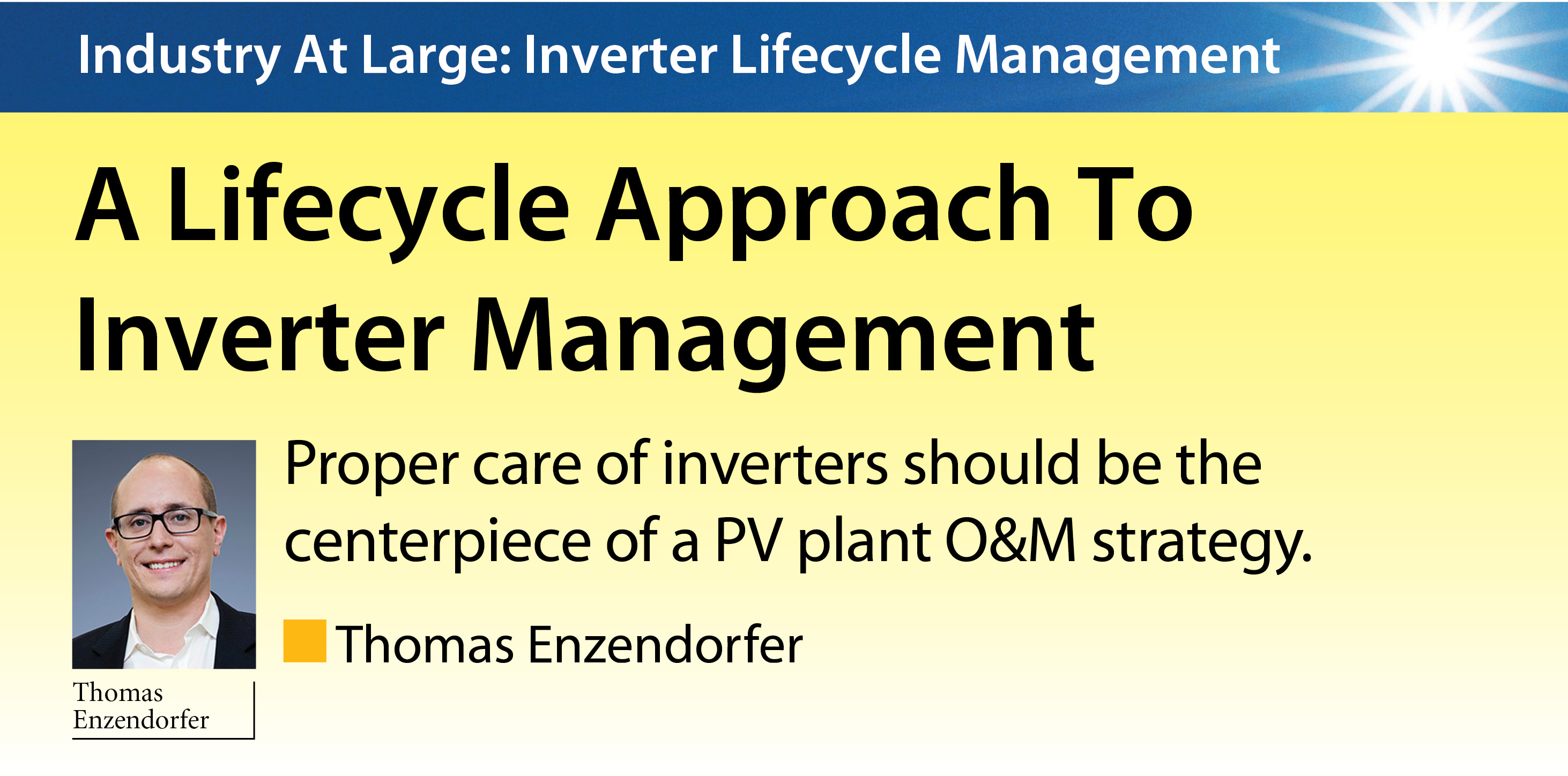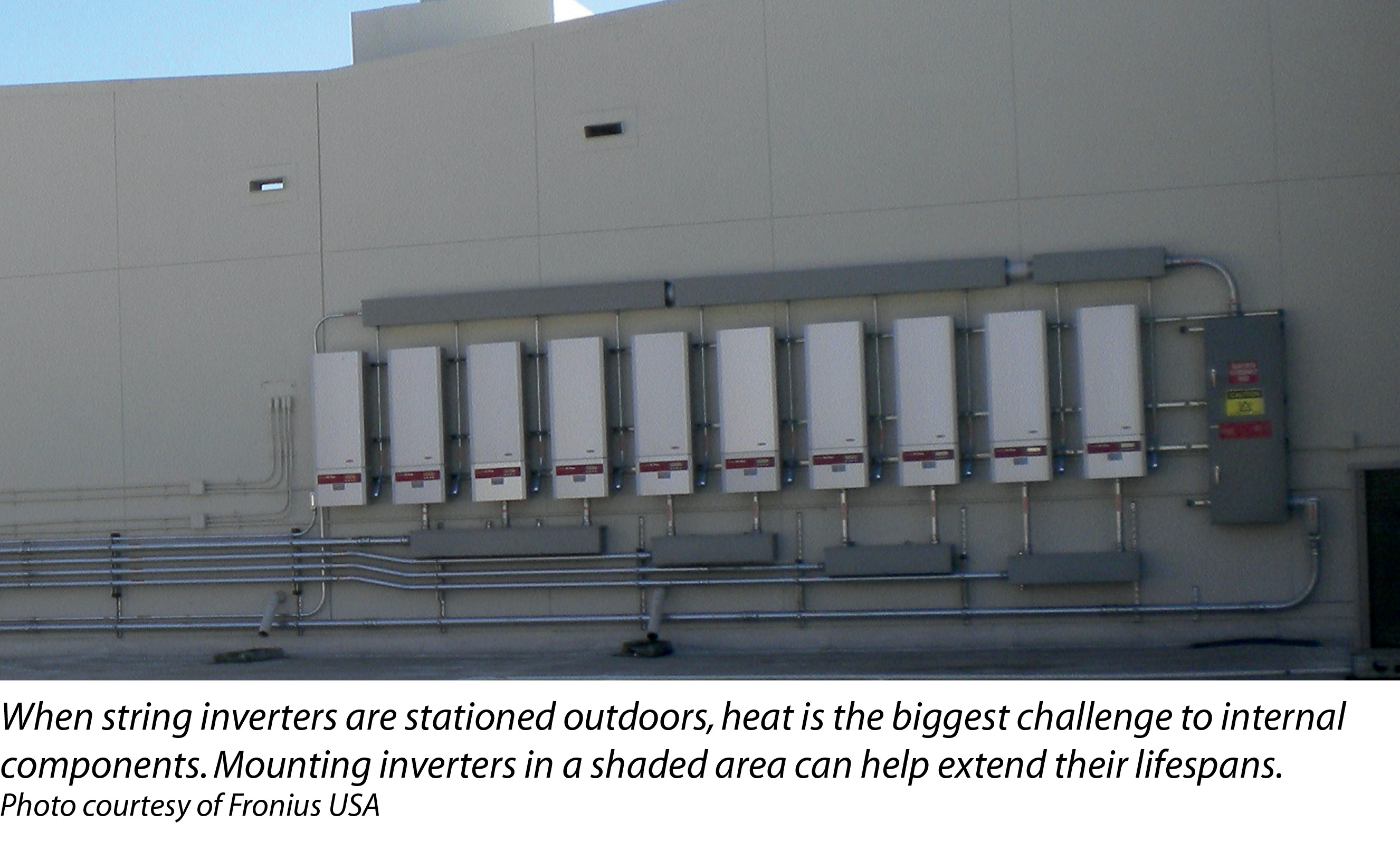

301 Moved Permanently
There is a saying about photovoltaic inverters that should cause all PV installers to reconsider - or begin considering - how they manage those devices after they are installed: An inverter comprises less than 20% of the cost of a PV system, but it takes with it up to 100% of the system’s energy production if it goes down due to a malfunction. When that happens, neither usable AC power nor return on customer investment is being generated. Plus, there can be immeasurable cost to the installer’s reputation.
A PV inverter is a complex mechanical device, prone to environmental stressors whether it is located indoors or outdoors. In a perfect world, every component would be able to handle an equal amount of stress, but because reality does not work that way, it is incumbent upon a PV installer to have in place a well-thought strategy for managing an inverter over its entire lifecycle, which could be as long as 20 to 30 years or more.
Inverter manufacturers are doing their part to aid installers in this area. For example, manufacturers began developing truly field-serviceable PV inverters in the mid-2000s, which included a modular design that isolates the various stages of an inverter for quicker access to the active components. Fronius shifted to a modular format in 2008. That approach is more efficient for the installer than completely removing a malfunctioning inverter and replacing it with a new unit. Another example is training programs predicated on servicing inverters at the customer site versus outright replacement.
The solar sector needs to provide continuous value over the lifecycle of a PV system, and the only way to do that is to keep the system running. The combination of truly field-serviceable inverters and service programs designed to minimize downtime and maximize energy yield, along with proactivity on behalf of the installer over the lifecycle of the inverter, will contribute to sustainable solar industry growth.
Inverter environmental stressors
A string PV inverter connects an array of multiple solar modules and can be mounted either indoors or outdoors. In either location, such an inverter faces many stressors over its lifespan.
When an inverter is stationed outdoors, heat is the biggest challenge to internal components, so the cooler an inverter can be, the better. Thus, wind becomes a major ally in this area, along with cold weather - but if the temperature reaches 0°F, the stress on internal components goes up. Some stressors are regional; inverters located outdoors near the ocean face salt buildup, which is a corrosive.
Another is physical placement - an inverter stationed on the south side of a building near the Mojave Desert will wilt under the searing heat, but the same inverter on the south side of a building in Wisconsin will be fine. But that Wisconsin inverter may also face daily heating and cooling, which can affect its components over time; if it’s a sunny day, the inverter might generate 100% of its capacity, but on a cloudy day, it could operate at 15%.
An inverter located indoors and out of direct sunlight faces many of those same stressors, though the effects are lessened by the building shell. But dust can be an issue, especially if it’s near a location such as a carpenter’s workshop. How hard an inverter works is a significant stress factor - an inverter is considered overdriven if it is running at 20% beyond its rated capacity, for example.
The bottom line for installers is that an inverter and its internal components face plenty of wear and tear on a daily basis. Given the same initial costs and other factors, field-serviceable string inverters are expected to incur an additional 5% of costs throughout the inverter’s lifetime. Non-field-serviceable string inverters are expected to incur 19% added costs, and non-field-serviceable microinverters will have an additional 26%. This puts field-serviceable inverters at a great advantage. Now factor in customers’ expectations to achieve return on investment (ROI) for their PV systems in a timely manner (a decent return is five years, but all installations vary), not to mention possibly double or even triple that ROI over the lifespan of an installation.
That’s a lot of pressure for an installer, but it doesn’t have to be paralyzing. Consider the following five steps that are crucial to inverter lifecycle management.
Incorporate lifecycle management into the installer business plan. This includes making sure an installer has service staff who can get to a customer’s home in a reasonable amount of time, and other practical factors. A certified installer can complete board-level replacements in the field in one visit, reducing system downtime to minutes instead of days. Operations and maintenance (O&M)providers should provide serviceability training for their installers to better enable lifecycle management.
Focus on data management and notification. When it comes to PV system downtime, a big variable is the time between when an inverter goes down to when the customer notices. If that inverter has data communications capability, the installer can receive an email notification, which can reduce that time significantly. Plug-in cards can send PV system values directly to online portals, providing the customer and the installer a system overview, and immediate notification if there is an inverter problem.
Consider inverter design. Reducing PV system downtime can also be tied to how an inverter is designed. Typically, the primary reason for an inverter failure is one malfunctioning component, and in the past, that one component could be hard to identify, which meant complete removal for servicing, or worse, replacement. A modular design makes it easier to isolate a malfunctioning component - for example, in select inverters, all the physical electrical connections are completed in one spot near the bottom, while the software-controlled power plant technology is located at the top. This allows the power boards to be quickly and easily replaced. Front displays can also provide a quick diagnosis if there is a problem, allowing the installer to address it without removal.
Get inverter manufacturer technical support involved during PV system design. Many installers see inverter tech support as reactive - somewhere to call if something happens. But consider that those team members are also well-versed in all application scenarios for their own products and are familiar with hundreds of applications, so using their expertise during PV system configuration is prudent. Technical support teams can make recommendations so the installer chooses the best inverter, datcom and accessories for the particular project. Tech support also has the latest updates on new products that the installer may not be made aware of yet.
Counsel customers on warranty considerations. Although government tax credits and similar programs can cover 30% to 80% of the initial cost of a PV system, they don’t cover post-warranty repairs, which fall to the system owner. Most inverter manufacturers have extendable warranties that are added at the time of purchase. Customers may also need to be reminded that, as with any appliance, they will need to cover the cost if an inverter needs servicing or replacement after the warranty ends, so correcting for this during system design can avoid extended downtime and higher cost later.
Sustainable industry growth
No one can predict the future, not even the savviest solar installer or inverter manufacturer. Solar industry innovation will continue to grow over the coming years and decades, leading to more robust inverter designs and service programs, including greater field serviceability. But the environmental stressors aren’t likely to change, and therefore, the need for inverter lifecycle management won’t either.
That means the decisions an installer makes with regard to lifecycle management - even today, after reading this article - will impact the future. That includes installing truly field-serviceable inverters and investing in training with a robust inverter service program, which impacts customer energy yield and ROI, and an installer’s ability to build a business. In short, it provides one of the best ways to provide continuous value today, tomorrow and decades from now - which will help maintain sustainable growth for the solar sector. R
Industry At Large: Inverter Lifecycle Management
A Lifecycle Approach To Inverter Management
By Thomas Enzendorfer
Proper care of inverters should be the centerpiece of a PV plant O&M strategy.
si body si body i si body bi si body b
si depbio
- si bullets
si sh
si subhead
pullquote
si first graph
si sh no rule
si last graph